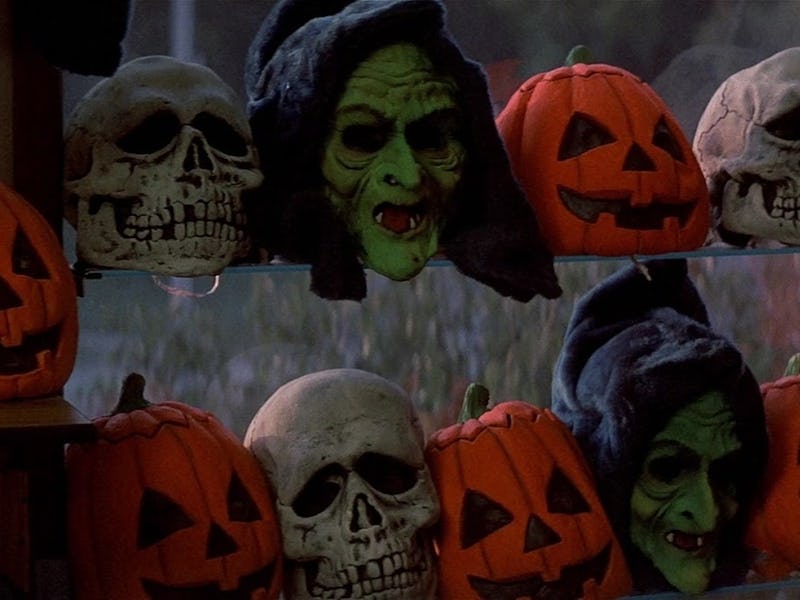How 'Halloween III: Season of the Witch' Invented the Shared Universe
The Michael Myers-less standalone entry in the 'Halloween' franchise tried and failed to do something new.

Imagine a Halloween movie without Michael Myers. That’s what filmmaker John Carpenter and his producing partner Debra Hill envisioned in 1982 when Universal Pictures called on the pair for a third installment of their popular horror series. The original became the highest grossing independent film of all time (a title it held for more than a decade), and a successful sequel followed in 1981. In the climax of Halloween II, Michael Myers was definitively dead, killed by an explosion caused by Donald Pleasence’s Dr. Sam Loomis. Carpenter and Hill wanted Michael Myers to stay dead, and their second sequel, Halloween III: Season of the Witch, thus wound up as the ballsiest move in horror history. It tried scrapping the story lines that made the first two movies ATMs (they’d grossed more than $70 million) and rewriting the series to keep the franchise going indefinitely. The standalone sci-fi plot tried to free the series from the single evil killer, and spawned the current trend of shared universes as we know them.
The idea was simple. Carpenter had ceded the director’s chair while remaining a producer, and for the third entry, Carpenter would enlist longtime collaborator Tommy Lee Wallace (who worked on the previous two Halloween movies) to both write and direct. Carpenter succinctly explained their process to The Hollywood Reporter this year, telling them, “I thought that we were done with telling stories about Michael Myers and the guy in the mask. I thought there’s not much more to say. So we thought we’d come up with a new story every year. We could call it Halloween, but it didn’t have to do anything with Michael Myers.”
The series would be reinvented as an anthology, with a new plot and new actors for each installment. The Halloween franchise would be turned into more than a movie — it would be an evergreen brand.
Carpenter, Hill, and Wallace’s new story would now explore the origins of the holiday itself and the ancient festival of Samhain. The film portrays an alcoholic doctor, Dan Challis (Tom Atkins), who stumbles upon an evil plot by an Irish toy maker named Conal Cochran (Dan O’Herlihy). Cochran, who is part of an ancient order of witches, plans a mass pagan sacrifice of children by using cursed masks that will kill anyone who wears them at 9 o’clock on Halloween night. How does he make sure that every unsuspecting child wears the masks? By running a series of TV ads touting a big prize giveaway from his toy company right before a multi-channel screening of a horror classic you might recognize: Halloween.
The cheesiness of Halloween III is offset by its potent subtext. It’s an ingenious satire of consumer culture, sending up mass-produced entertainment while playing with some very brutal concepts. This is, after all, a movie with an antagonist who wants to ostensibly kill every child in the world using black magic. What’s more, it uses the backdrop of the holiday more effectively than the first two movies. Michael Myers stalks and kills his victims and it just so happens to be October 31st. Cochran’s plan hinges on kids settling in for a scary movie after trick-or-treating.
Scary-ass idea, right? The movie tanked. Vincent Canby pointed out its inherent ridiculousness, accusing it of being “anti-children, anti-capitalism, anti-television and anti-Irish all at the same time.” Roger Ebert gave it one-and-a-half stars as “a low-rent thriller from the first frame.” Audiences didn’t show up either, perhaps perplexed by the lack of a white-masked villain, huge knives, and Jamie Lee Curtis. It remains the second-lowest-grossing film in the long franchise.
People looking for Michael Myers without finding him just didn’t look hard enough. He may not have been the film’s main villain, but he’s there. While waiting at a bar for a character named Ellie Grimbridge, whose father died while trying to escape Cochran, Challis asks the bartender to change the channel on a nearby TV only to have the barman stop at a commercial showing footage of the first Halloween movie. Later, when Cochran captures Challis and forces him to wear a mask to be killed at 9 p.m., another commercial featuring the first movie’s distinct theme music and shots of both Michael Myers and actress Jamie Lee Curtis play on a TV. Curtis herself can also be heard as the voice of a phone operator that Challis calls to get the screening and Cochran’s commercials scrubbed from the air.
This is all to say that Halloween III had the foresight to at least acknowledge its roots. It wove together the iconography and scenes of its own mythology, and if it continued on could have been increasingly intricate. In that way, it pre-dates the shared universes of huge Hollywood franchises like the Marvel Cinematic Universe. Except where Marvel continues to rake in billions, Halloween III proved, at least at that point, that audiences preferred more of the same.
What could have been? Had the idea clicked, who knows what Halloween 4 or Halloween 5 could have been about. The Twilight Zone-esque possibilities could have been endless, and yet all people looked forward to was a mute, masked hulk returning to kill again for increasingly dumb reasons. Carpenter himself seems OK with it, telling THR, “I like the movie a lot. It’s kind of a subversive movie but very interesting.”
Perhaps if the standalone idea was introduced in Halloween II, audiences would have understood the larger idea that the filmmakers wanted to try out. Still, the roots of the shared universe all go back to Carpenter, a misunderstood genius whose collaborative experiment remains equally misunderstood.